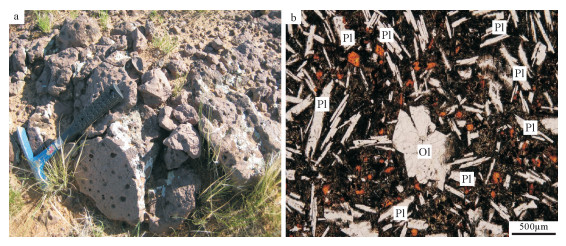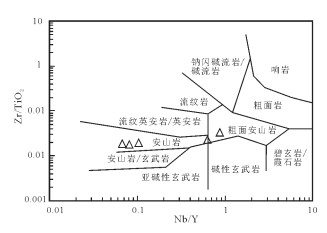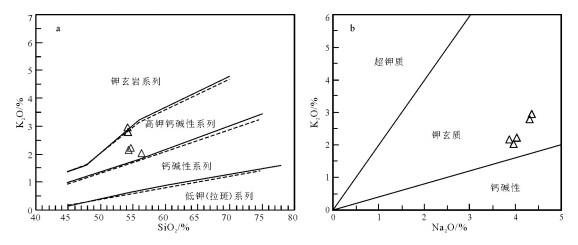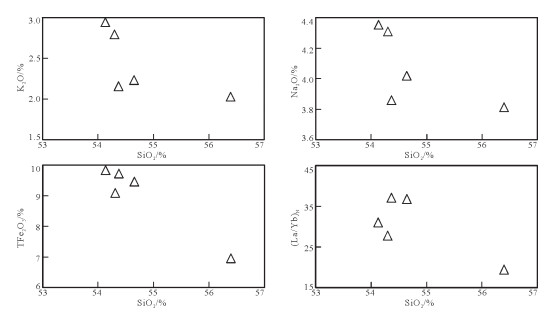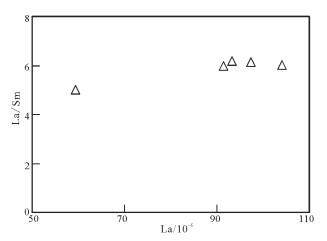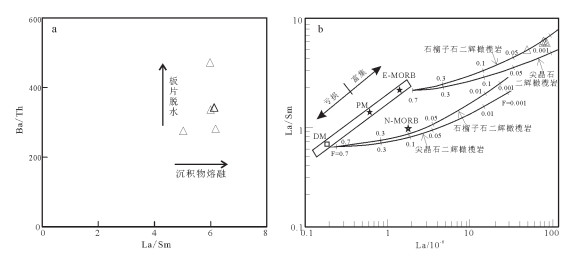Geochemistry and petrogenesis of the volcanic rocks from the Abaga Formation in Sonid Left Banner, central Inner Mongolia
-
摘要:
内蒙古中部苏尼特左旗地区阿巴嘎组火山岩主要由安山岩组成。岩石富碱、高钾和铝、低镁。富集大离子亲石元素(LILEs)Rb、Ba、U、K和轻稀土元素(LREE),相对亏损高场强元素(HFSEs),具明显的Nb、Ta和Ti负异常和Pb正异常。稀土元素总量较高,轻、重稀土元素分馏强烈且属轻稀土元素富集型,具弱负Eu异常。主量、微量元素地球化学特征表明,阿巴嘎组安山岩为钾质火山岩,岩浆上升演化过程中经历了斜长石和铁镁矿物的分离结晶作用,无地壳物质的混染。阿巴嘎组钾质火山岩的形成与新生代太平洋板片俯冲密切相关,其岩浆来源于滞留的俯冲太平洋板片释放流体交代的富集陆下岩石圈地幔,是在板内伸展体制下含金云母石榴子石二辉橄榄岩低程度部分熔融的产物。这种板内伸展体制可能是新生代滞留于地幔过渡带中的太平洋板片俯冲后撤引起的。
Abstract:The volcanic rocks of the Abaga Formation in Sonid Left Banner area of central Inner Mongolia are mainly composed of andesites. These andesites have high alkali, potassium and aluminum, but low magnesium, and are obviously enriched in LILEs such as Rb, Ba, U, K and LREE, and depleted in HFSEs such as Nb, Ta, Ti with obvious negative anomalies. They have high ∑REE values, and show intense REE fractionation with LREE enrichment and weak negative Eu anomalies. Their geochemical characteristics suggest that they belong to potassic volcanic rocks, and were likely generated from a small degree of partial melting of phlogopite-bearing garnet lherzolite in an enriched sub-lithospheric mantle. The enriched sub-lithospheric mantle was metasomatized by fluids released from the stagnant Pacific slab in the mantle transition zone. Geochemical features also reveal that fractional crystallization with the removal of plagioclase and ferromagnesian minerals played an important role in the evolution, and the potassic magma was not affected by crustal contamination as it passed through the thick continental crust. These potassic rocks were formed in an intraplate extensional tectonic setting resulting from the rollback of the stagnant Pacific slab in the mantle transition zone.
-
Keywords:
- Abaga Formation /
- potassic volcanic rocks /
- geochemistry /
- slab rollback /
- central Inner Mongolia
-
致谢: 河北地质大学方勇勇教授和许圣传博士,以及张振民、李伟龙、刘亚芳、王广、王洋、焦天佳、秦旭亮、谷凤羽、李晓伟等硕士研究生参加了野外工作,审稿专家提出了建设性的修改意见,在此一并表示衷心感谢。
-
图 1 研究区所在位置及地质简图
a—中国东北大地构造简图(据参考文献[13]修改);b—研究区地质简图;E2y—伊尔丁曼哈组;C2bl—宝力高庙组;Qpa—阿巴嘎组;C2ζγ—正长花岗岩;C2γδ—花岗闪长岩;1—安山岩;2—不整合界线;3—产状;4—采样位置;5—剖面线
Figure 1. The tectonic location of the study area and geological sketch map
图 2 研究区阿巴嘎组火山岩地质剖面(剖面位置见图 1-b)
1—砂砾岩;2—致密块状安山岩;3—气孔杏仁状安山岩;4—正长花岗岩;5—不整合接触;E2y—伊尔丁曼哈组;Qpa—阿巴嘎组;C2ζγ—正长花岗岩
Figure 2. Geological section of the volcanic rocks from the Abaga Formation in the study area
图 4 研究区阿巴嘎组火山岩Nb/Y-Zr/TiO2分类图
(底图据参考文献[35])
Figure 4. Nb/Y-Zr/TiO2 diagram of the volcanic rocks from the Abaga Formation in the study area
表 1 研究区阿巴嘎组安山岩主量、微量和稀土元素含量
Table 1 Major, trace element and REE compositions of the andesites from the Abaga Formation in the study area
样品号 D0332 D4374 PM039 D7300 D2352 SiO2 52.24 52.63 53.72 51.76 52.80 TiO2 2.41 2.74 2.37 2.72 2.70 Al2O3 15.60 15.78 16.30 15.39 15.10 TFe2O3 8.74 9.56 6.59 9.24 9.12 MnO 0.114 0.067 0.092 0.083 0.109 MgO 1.94 1.90 1.97 1.87 2.53 CaO 6.96 5.95 7.55 7.00 6.79 Na2O 4.14 4.23 3.76 3.67 3.88 k2O 2.68 2.87 1.93 2.05 2.15 P2O5 1.38 1.49 0.971 1.42 1.44 烧失量 3.72 2.26 4.57 4.39 2.84 总量 99.92 99.48 99.82 99.59 99.46 Mg# 34 32 41 32 39 A/CNK 0.70 0.76 0.76 0.74 0.72 Na2O+K2O 6.82 7.10 5.69 5.72 6.03 K2O/Na2O 0.65 0.68 0.51 0.56 0.55 Sc 11.6 17.1 16.7 15.9 15.4 V 152 147 168 177 164 Cr 52.7 64.6 77.6 56.3 61.5 Co 34.5 19.6 25.4 20.2 22.2 Ni 24.2 26.4 23 21.8 21.8 Ga 24.9 42.8 30.3 40.9 38.3 Rb 37.4 50.5 42.7 43.0 42.1 Sr 1160 1213 762 1276 1194 Y 29.5 35.6 29.7 27.5 25.6 Nb 25.70 3.66 20.00 1.89 2.08 Mo 2.63 1.31 1.74 1.13 1.40 Cd 0.441 0.167 0.174 0.173 0.149 In 0.081 0.102 0.085 0.079 0.067 Cs 2.460 1.020 0.872 0.862 0.891 Ba 1331 1681 1007 1514 1970 Ta 1.280 0.019 0.585 0.040 0.011 Re 0.005 0.004 0.017 0.014 < 0.002 Tl 0.158 0.156 0.413 0.540 0.263 Bi 0.051 0.072 0.056 0.053 0.053 Th 4.71 5.00 3.67 4.42 4.15 U 2.06 1.77 1.22 1.46 1.58 Zr 825 548 454 523 500 Hf 18.3 12.3 10.3 11.3 11.0 La 93.3 104.0 59.3 97.4 91.4 Cc 180 195 120 189 182 Pr 22.8 26.9 15.4 24.5 23.2 Nd 88.8 109.0 65.0 98.8 93.8 Sm 15.1 17.3 11.8 15.9 15.3 Eu 3.52 4.39 3.23 4.06 3.70 Gd 11.7 12.6 9.59 11.2 11.1 Tb 1.65 1.81 1.44 1.43 1.48 Dy 6.11 7.21 5.81 5.96 5.77 Ho 1.010 1.230 0.976 1.010 0.974 Er 3.05 3.15 2.55 2.31 2.13 Tm 0.379 0.411 0.378 0.304 0.251 Yb 2.28 2.28 2.08 1.78 1.68 Lu 0.326 0.324 0.267 0.248 0.215 ∑REE 430.03 485.61 297.82 453.9 433 LREE/HREE 15.22 15.74 11.90 17.72 17.35 (La/Yb)N 27.59 30.75 19.22 36.89 36.68 (La/Sm)N 3.89 3.78 3.16 3.85 3.76 (Gd/Yb)N 4.14 4.46 3.72 5.08 5.33 δEu 0.78 0.87 0.90 0.89 0.83 Ba/Th 282.59 336.2 274.39 342.53 474.70 La/Sm 6.18 6.01 5.03 6.13 5.97 K/Rb 594.85 471.78 375.21 395.76 423.94 La/Yb 40.92 45.61 28.51 54.72 54.4 Dy/Yb 2.68 3.16 2.79 3.35 3.43 Rb/Ba 0.03 0.03 0.04 0.03 0.02 Rb/Sr 0.03 0.04 0.06 0.03 0.04 Tb/Yb 0.72 0.79 0.69 0.8 0.88 Zr/Hf 45.08 44.55 44.08 46.28 45.45 注:Mg#=100×Mg2+/( Mg2++Fe3+);主量元素含量单位为%,微量和稀土元素含量为 10-6 -
赵勇伟, 樊祺诚, 白志达, 等.大兴安岭诺敏河-奎勒河地区第四纪火山活动研究[J].中国科学:地球科学, 2013, 43(9):1464-1473. http://www.wanfangdata.com.cn/details/detail.do?_type=perio&id=zgkx-cd201309008 Zhang J H, Gao S, Ge W C, et al. Geochronology of the Mesozoic volcanic rocks in the Great Xing'an Range, northeastern China:Implications for subduction-induced delamination[J]. Chemical Geology, 2010, 276:144-165. doi: 10.1016/j.chemgeo.2010.05.013
邓晋福, 赵海玲, 莫宣学, 等.中国大陆根-柱构造-大陆动力学的钥匙[M].北京:地质出版社, 1996:1-110. Deng J F, Mo X X, Zhao H L, et al. A new model for the dynamic evolution of Chinese lithosphere:'continental roots-plume tectonics'[J]. Earth-Science Reviews, 2004, 65:223-275. doi: 10.1016/j.earscirev.2003.08.001
Liu J, Han J, Fyfe W S. Cenozoic episodic volcanism and continental rifting in northeast China and possible link to Japan Sea development as revealed from K-Ar geochronology[J]. Tectonophysics, 2001, 339:385-401. doi: 10.1016/S0040-1951(01)00132-9
Xu Y G, Ma J L, Frey F A, et al. Role of lithosphere-asthenosphere interaction in the genesis of Quaternary alkali and tholeiitic basalts from Datong, western North China Craton[J]. Chemical Geology, 2005, 224:247-271. doi: 10.1016/j.chemgeo.2005.08.004
Zhao Y W, Fan Q C, Zou H B, et al. Geochemistry of Quaternary basaltic lavas from the Nuomin volcanic fi eld, Inner Mongolia:Implications for the origin of potassic volcanic rocks in Northeastern China[J]. Lithos, 2014, 196:169-180. https://www.researchgate.net/publication/260914220_Geochemistry_of_Quaternary_basaltic_lavas_from_the_Nuomin_volcanic_field_Inner_Mongolia_Implications_for_the_origin_of_potassic_volcanic_rocks_in_Northeastern_China
Zou H B, Fan Q C, Yao Y P. U-Th systematics of dispersed young volcanoes in NE China:Asthenosphere upwelling caused by piling up and upward thickening of stagnant Paci fi c slab[J]. Chemical Geology, 2008, 255:134-142. doi: 10.1016/j.chemgeo.2008.06.022
Zhang M L, Guo Z F. Origin of Late Cenozoic Abaga-Dalinuoer basalts, eastern China:Implications for a mixed pyroxeniteperidotite source related with deep subduction of the Pacific slab[J]. Gondwana Research, 2016, 37:130-151. doi: 10.1016/j.gr.2016.05.014
Kuritani T, Ohtani E, Kimura J I. Intensive hydration of the mantle transition zone beneath China caused by ancient slab stagnation[J]. Nature Geoscience, 2011, 4:713-716. doi: 10.1038/ngeo1250
Kuritani T, Kimura J I, Ohtani E, et al. Transition zone origin of potassic basalts from Wudalianchi volcano, northeast China[J]. Lithos, 2013, 156/159:1-12. doi: 10.1016/j.lithos.2012.10.010
Ho K S, Liu Y, Chen J C, et al. Elemental and Sr-Nd-Pb isotopic compositions of late Cenozoic Abaga basalts, Inner Mongolia:Implications for petrogenesis and mantle process[J]. Geochemical Journal, 2008, 42:339-357. doi: 10.2343/geochemj.42.339
Ho K S, Ge W C, Chen J C, et al. Late Cenozoic magmatic transitions in the central Great Xing'an Range, Northeast China:Geochemical and isotopic constraints on petrogenesis[J]. Chemical Geology, 2013, 352:1-18. doi: 10.1016/j.chemgeo.2013.05.040
赵勇伟, 樊祺诚.大兴安岭哈拉哈河-绰尔河第四纪火山岩地幔源区与岩浆成因[J].岩石学报, 2012, 28(4):1119-1129. http://d.old.wanfangdata.com.cn/Conference/7667379 Chu Z Y, Harvey J, Liu C Z, et al. Source of highly potassic basalts in Northeast China:Evidence from Re-Os, Sr-Nd-Hf isotopes and PGE geochemistry[J]. Chemical Geology, 2013, 357:52-66. doi: 10.1016/j.chemgeo.2013.08.007
Fan Q C, Chen S S, Zhao Y W, et al. Petrogenesis and evolution of Quaternary basaltic rocks from the Wulanhada area, North China[J]. Lithos, 2014, 206:289-302. http://cn.bing.com/academic/profile?id=0fcba665749c3609ed17ac09fac35f96&encoded=0&v=paper_preview&mkt=zh-cn
Chen S S, Fan Q C, Zou H B, et al. Geochemical and Sr-Nd isotopic constraints on the petrogenesis of late Cenozoic basalts from the Abaga area, Inner Mongolia, eastern China[J]. Journal of Volcanology and Geothermal Research, 2015, 305:30-44. doi: 10.1016/j.jvolgeores.2015.09.018
Guo P Y, Niu Y L, Sun P, et al. The origin of Cenozoic basalts from central Inner Mongolia, East China:The consequence of recent mantle metasomatism genetically associated with seismically observed paleo-Pacific slab in the mantle transition zone[J]. Lithos, 2016, 240/243:104-118. doi: 10.1016/j.lithos.2015.11.010
陈生生, 樊祺诚, 赵勇伟, 等.内蒙古贝力克玄武岩地球化学特征及地质意义[J].岩石学报, 2013, 29(8):2695-2708. http://www.wanfangdata.com.cn/details/detail.do?_type=perio&id=ysxb98201308007 樊祺诚, 赵勇伟, 陈生生, 等.大兴安岭-太行山重力梯度带以西的第四纪火山活动[J].矿物岩石地球化学通报, 2015, 34(4):674-681. doi: 10.3969/j.issn.1007-2802.2015.04.001 Xiao W J, Windley B F, Hao J, et al. Accretion leading to collision and the Solonker suture, Inner Mongolia, China:Termination of the Central Asian Orogenic Belt[J]. Tectonics, 2003, 22:1069-1088. http://cn.bing.com/academic/profile?id=4f70f4625c75e2c67f49e664df0bc8b5&encoded=0&v=paper_preview&mkt=zh-cn
Miao L C, Fan W M, Liu D Y, et al. Geochronology and geochemistry of the Hegenshan ophiolitic complex:Implications for late-stage tectonic evolution of the Inner Mongolia-Daxinganling orogenic belt, China[J]. Journal of Asian Earth Sciences, 2008, 32:348-370. doi: 10.1016/j.jseaes.2007.11.005
徐备, 赵盼, 鲍庆中, 等.兴蒙造山带前中生代构造单元划分初探[J].岩石学报, 2014, 30(7):1841-1857. http://d.old.wanfangdata.com.cn/Periodical/ysxb98201407001 郭锋, 范蔚茗, 王岳军, 等.大兴安岭南段晚中生代双峰式火山作用[J].岩石学报, 2001, 17(1):61-68. http://d.old.wanfangdata.com.cn/Periodical/ysxb98200101017 林强, 葛文春, 曹林, 等.大兴安岭中生代双峰式火山岩的地球化学特征[J].地球化学, 2003, 32(3):208-222. doi: 10.3321/j.issn:0379-1726.2003.03.002 洪大卫, 黄怀曾, 肖宜君, 等.内蒙古中部二叠纪碱性花岗岩及其地球动力学意义[J].地质学报, 1994, 68(3):219-230. doi: 10.3321/j.issn:0001-5717.1994.03.001 李可, 张志诚, 冯志硕, 等.内蒙古中部巴彦乌拉地区晚石炭世-早二叠世火山岩锆石SHRIMP U-Pb定年及其地质意义[J].岩石学报, 2014, 30(7):2041-2054. http://d.old.wanfangdata.com.cn/Conference/8159504 贺淑赛, 李秋根, 王宗起, 等.内蒙古中部宝力高庙组长英质火山岩U-Pb-Hf同位素特征及其地质意义[J].北京大学学报(自然科学版), 2015, 51(1):49-64. http://d.old.wanfangdata.com.cn/Periodical/bjdxxb201501007 Tong Y, Jahn B M, Wang T, et al. Permian alkaline granites in the Erenhot-Hegenshan belt, northern Inner Mongolia, China:Model of generation, time of emplacement and regional tectonic significance[J]. Journal of Asian Earth Sciences, 2015, 97:320-336. doi: 10.1016/j.jseaes.2014.10.011
Zhang X H, Yuan L L, Xue F H, et al. Early Permian A-type granites from central Inner Mongolia, North China:Magmatic tracer of postcollisional tectonics and oceanic crustal recycling[J]. Gondwana Research, 2015, 28:311-327. doi: 10.1016/j.gr.2014.02.011
Kononova V A, Kurat G, Embey-Isztin A, et al. Geochemistry of metasomatised spinel peridotite xenoliths from the Dariganga Plateau, Southeastern Mongolia[J]. Mineralogy and Petrology, 2002, 75:1-21. doi: 10.1007/s007100200012
内蒙古地质矿产局.内蒙古自治区区域地质志[M].北京:地质出版社, 1991:1-725. 张臣, 刘树文, 韩宝福, 等.内蒙古阿巴嘎旗新生代玄武岩包体的特征[J].岩石学报, 2006, 22(11):2801-2807. http://www.wanfangdata.com.cn/details/detail.do?_type=perio&id=ysxb98200611018 陈生生, 樊祺诚, 赵勇伟, 等.内蒙古阿巴嘎地幔岩捕掳体与岩石圈地幔性质探讨[J].岩石学报, 2012, 28(4):1108-1118. http://d.old.wanfangdata.com.cn/Conference/7667380 Winchester J A, Floyd P A. Geochemical discrimination of different magma series and their differentiation products using immobile elements[J]. Chemical Geology, 1977, 20:325-343. doi: 10.1016/0009-2541(77)90057-2
Rickwood P C. Boundary lines within petrologic diagrams which use oxides major and minor elements[J]. Lithos, 1989, 22:247-263. doi: 10.1016/0024-4937(89)90028-5
Miller C, Schuster R, Klotzli U, et al. Post-collisional potassic and ultrapotassic magmatism in SW Tibet:Geochemical and Sr-NdPb-O isotopic constraints for mantle source characteristics and petrogenesis[J]. Journal of Petrology, 1999, 40:1399-1424. doi: 10.1093/petroj/40.9.1399
Morrison G W. Characteristics and tectonic setting of the shoshonite rock association[J]. Lithos, 1980, 13:97-108. doi: 10.1016/0024-4937(80)90067-5
Sun S S, Mcdonough W F. Chemical and isotopic systematics of oceanic basalt: Implication for mantle composition and processes[C]//Saunders A D, Norry M J. Magmatism in the Ocean Basins. Geological Society Special. Publications, 1989, 42: 313-345.
Saunders A D, Tarney J, Weaver S D. Transverse geochemical variations across the Antarctic Peninsula:Implications for the genesis of calc-alkaline magmas[J]. Earth and Planetary Science Letters, 1980, 46:344-360. doi: 10.1016/0012-821X(80)90050-3
梅可辰, 李秋根, 王宗起, 等.内蒙古中部苏尼特左旗大石寨组流纹岩SHRIMP锆石U-Pb年龄、地球化学特征及其构造意义[J].地质通报, 2015, 34(12):2181-2194. doi: 10.3969/j.issn.1671-2552.2015.12.005 Boynton W V. Geochemistry of the rare earth elements: Meteorite studies[C]//Henderson P. Rare Earth Element Geochemistry. Amsterdam Elsevier, 1984: 63-114.
Tang Y J, Zhang H F, Ying J F. Asthenosphere-lithospheric mantle interaction in an extensional regime:implication from the geochemistry of Cenozoic basalts from Taihang Mountains, North China Craton[J]. Chemical Geology, 2006, 233:309-327. doi: 10.1016/j.chemgeo.2006.03.013
Xu Y G, Zhang H H, Qiu H N, et al. Oceanic crust components in continental basalts from Shuangliao, Northeast China:Derived from the mantle transition zone?[J] Chemical Geology, 2012, 328:168-184. doi: 10.1016/j.chemgeo.2012.01.027
Rudnick R L, Gao S. Composition of the continental crust[C]//Rudnick R L. The Crust, Treatise on geochemistry[M]. Amsterdam: Elsevier, 2003, 3: 1-64.
Zhang L C, Zhou X H, Ying J F, et al. Geochemistry and Sr-NdPb-Hf isotopes of Early Cretaceous basalts from the Great Xinggan Range, NE China:Implications for their origin and mantle source characteristics[J]. Chemical Geology, 2008, 256:12-23. doi: 10.1016/j.chemgeo.2008.07.004
Turner S, Hawkesworth C. Constraints on flux rates and mantle dynamics beneath island arcs from Tonga-Kermadec lava geochemistry[J]. Nature, 1997, 389:568-573. doi: 10.1038/39257
Labanieh S, Chauvel C, Germa A, et al. Martinique:A clear case for sediment melting and slab dehydration as a function of distance to the trench[J]. Journal of Petrology, 2012, 53:2441-2464. doi: 10.1093/petrology/egs055
Zhang H F, Nakamura E, Sun M, et al. Transformation of subcontinental lithospheric mantle through peridotite-melt reaction:Evidence from a highly fertile mantle xenolith fromthe north China Craton[J]. International Geology Review, 2007, 49:658-679. doi: 10.2747/0020-6814.49.7.658
Sun W D, Teng F Z, Niu Y L, et al. The subduction factory:Geochemical perspectives[J]. Geochimica et Cosmochimica Acta, 2014, 143:1-7. doi: 10.1016/j.gca.2014.06.029
Ayers J C, Dittmer S K, Layne G D. Partitioning of elements between peridotite and H2O at 2.0-3.0GPa and 900-1100℃, and application to models of subduction zone processes[J]. Earth and Planetary Science Letters, 1997, 150:381-398. doi: 10.1016/S0012-821X(97)00096-4
Kessel R, Schmidt M W, Ulmer P, et al. Trace element signature of subduction-zone fluids, melts and supercritical liquids at 120-180km depth[J]. Nature, 2005, 437:724-727. doi: 10.1038/nature03971
Yang W B, Niu H C, Cheng L R, et al. Geochronology, geochemistry and geodynamic implications of the Late Mesozoic volcanic rocks in the southern Great Xing'an Mountains, NE China[J]. Journal of Asian Earth Sciences, 2015, 113:454-470. doi: 10.1016/j.jseaes.2014.12.002
Huang J, Zhao D. High-resolution mantle tomography of China and surrounding regions[J]. Journal of Geophysical Research, 2006, 111(B9305):1-21. http://www.wanfangdata.com.cn/details/detail.do?_type=perio&id=d9e8da1e9c0b55380dcff40b5e598512
Zhao D, Zheng Y, Ohtani E. East Asia:Seismotectonics, magmatism and mantle dynamics[J]. Journal of Asian Earth Sciences, 2011, 40:689-709. doi: 10.1016/j.jseaes.2010.11.013
Li J, Wang X, Wang X, et al. P and SH velocity structure in the upper mantle beneath Northeast China:Evidence for a stagnant slab in hydrous mantle transition zone[J]. Earth and Planetary Science Letters, 2013, 367:71-81. doi: 10.1016/j.epsl.2013.02.026
Zhu Y F, Guo X, Song B, et al. Petrology, Sr-Nd-Hf isotopic geochemistry and zircon chronology of the Late Palaeozoic volcanic rocks in the southwestern Tianshan Mountains, Xinjiang, NW China[J]. Journal of the Geological Society, 2009, 166:1085-1099. doi: 10.1144/0016-76492008-130
Conticelli S, Marchionni S, Rosa D, et al. Shoshonite and subalkaline magmas from an ultrapotassic volcano:Sr-Nd-Pb isotope data on the Roccamonfina volcanic rocks, Roman Magmatic Province, Southern Italy[J]. Contributions to Mineralogy and Petrology, 2009, 157:41-63. doi: 10.1007/s00410-008-0319-8
Ionov D A, Hofmann A W. Nb-Ta-rich mantle amphiboles and micas-implications for subduction-related metasomatic traceelement fractionations[J]. Earth and Planetary Science Letters, 1995, 131:341-356. doi: 10.1016/0012-821X(95)00037-D
Chazot G, Menzies M A, Harte B. Determination of partition coefficients between apatite, clinopyroxene, amphibole, and melt in natural spinellherzolites from Yemen:Implications for wet melting of the lithospheric mantle[J]. Geochimica et Cosmochimica Acta, 1996, 60:423-437. doi: 10.1016/0016-7037(95)00412-2
Chakrabarti R, Basu A R, Santo A P, et al. Isotopic and geochemical evidence for a heterogeneous mantle plume origin of the Virunga volcanics, Western rift, East African Rift system[J]. Chemical Geology, 2009, 259:273-289. doi: 10.1016/j.chemgeo.2008.11.010
Adam J, Green T. Trace element partitioning between mica-and amphibole-bearing garnet lherzolite and hydrous basanitic melt:1. Experimental results and the investigation of controls on partitioning behaviour[J]. Contributions to Mineralogy and Petrology, 2006, 152:1-17. doi: 10.1007/s00410-006-0085-4
Yang W B, Niu H C, Shan Q, et al. Late Paleozoic calc-alkaline to shoshonitic magmatism and its geodynamic implications, Yuximolegai area, western Tianshan, Xinjiang[J]. Gondwana Research, 2012, 22:325-340. doi: 10.1016/j.gr.2011.10.008
Jiang Y H, Jiang S Y, Dai B Z, et al. Middle to late Jurassic felsic and ma fi c magmatism in southern Hunan province, southeast China:Implications for a continental arc to rifting[J]. Lithos, 2009, 107:185-204. doi: 10.1016/j.lithos.2008.10.006
Zou H, Reid M R, Liu Y, et al. Constraints on the origin of historic potassic basalts from Northeast China by U-Th disequilibrium data[J]. Chemical Geology, 2003, 200:189-201. doi: 10.1016/S0009-2541(03)00188-8
Chu Z Y, Wu F Y, Walker R J, et al. Temporal evolution of the lithospheric mantle beneath the eastern North China Craton[J]. Journal of Petrology, 2009, 50:1857-1898. doi: 10.1093/petrology/egp055
Class C, Goldstein S L. Plume-lithosphere interactions in the ocean basins:Constraints from the source mineralogy[J]. Earth and Planetary Science Letters, 1997, 150:245-260. doi: 10.1016/S0012-821X(97)00089-7
Campbell I H, Grif fi ths R W. Implications of mantle plume structure for the evolution of flood basalts[J]. Earth and Planetary Science Letters, 1990, 99:79-93. doi: 10.1016/0012-821X(90)90072-6
Chen Y, Zhang Y X, Graham D, et al. Geochemistry of Cenozoic basalts and mantle xenoliths in Northeast China[J]. Lithos, 2007, 96:108-126. doi: 10.1016/j.lithos.2006.09.015
Zhao D. Global tomographic images of mantle plumes and subducting slabs:Insight into deep Earth dynamics[J]. Physics of the Earth and Planetary Interiors, 2004, 146:3-34. doi: 10.1016/j.pepi.2003.07.032
许志琴, 杨经绥, 嵇少丞, 等.中国大陆构造及动力学若干问题的认识[J].地质学报, 2010, 84(1):1-29. http://d.old.wanfangdata.com.cn/Periodical/dizhixb201001001 Ren J Y, Tamaki K, Li S T, et al. Late Mesozoic and Cenozoic rifting and its dynamic setting in Eastern China and adjacent areas[J]. Tectonophysics, 2002, 344:175-205. doi: 10.1016/S0040-1951(01)00271-2
内蒙古自治区地质调查院.内蒙古1:25万巴音乌拉幅(L49C004004)区域地质调查报告.2007. 石家庄经济学院地质调查研究院.内蒙古1:5万准和热木音苏木(L49E021018)等六幅区域地质调查报告.2015.



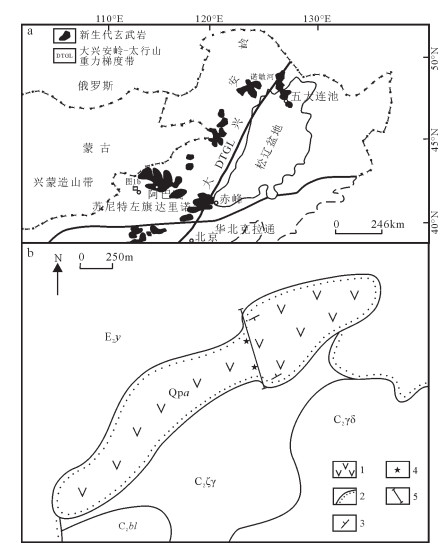
 下载:
下载:

